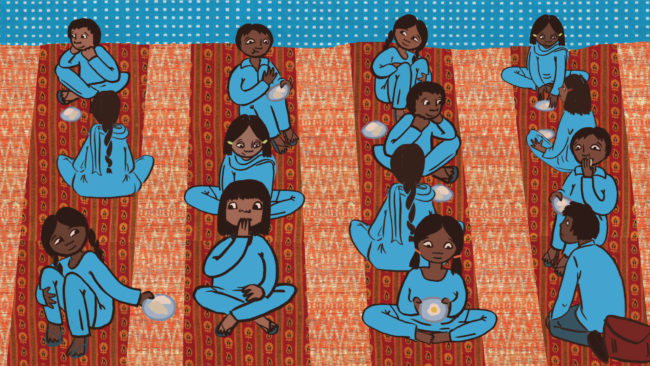
Lisa LaBracio/Courtesy of the Pulitzer Center
India is in the midst of a war of sorts — a war over eggs. To eat them, or not to eat them. Actually, it’s more about whether the government should give free eggs to poor, malnourished children.
It all began in late May, when Shivraj Chouhan, the chief minister of the Indian state of Madhya Pradesh, shot down a proposal to serve eggs in government-run day care centers (anganwadis) in some tribal areas.
These communities have high rates of malnutrition, says Sachin Jain, a local food-rights activist in the state. “The idea behind the proposal was to address the gap in protein deficiency through … eggs,” he says.
But Chouhan wasn’t convinced. As Indian newspapers reported, he publicly vowed not to allow eggs to be served as long as he was minister.
Why this vehement opposition to eggs? Well, the local community of Jains, which is strictly vegetarian and also powerful in the state, has previously thwarted efforts to introduce eggs in day care centers and schools. Chouhan is an upper caste Hindu man who recently became a vegetarian.
And the state of Madhya Pradesh is mostly vegetarian, as are some other states, like Karnataka, Rajasthan and Gujarat. For years, the more politically vocal vegetarians in these states have kept eggs out of school lunches and anganwadis.
But here’s the thing: While these states as a whole may be mostly vegetarian, the poorest — and most malnourished — Indians generally are not. They would eat eggs, if only they could afford them, says Dipa Sinha, an economist at the Center for Equity Studies in New Delhi and an expert on India’s preschool and school feeding programs.
India’s free school lunch program alone reaches about 120 million of India’s poorest children, and the anganwadis reach millions of younger children. So, the egg war isn’t trivial.
Chouhan’s office has said the chief minister is “sentimental” about keeping anganwadis egg-free. “This is a very upper caste Hindu sentiment,” says Sinha.
Hindu scriptures prescribe notions of purity for people belonging to upper castes, Sinha explains. “You can’t use the same spoon as someone else. You can’t sit next to someone eating meat. You can’t eat food cooked by someone who eats meat. And they think this is a dominant culture and that they can impose it on anyone.”
The recent ban on the slaughter of bulls and bullocks in the neighboring state of Maharashtra also reflects this sentiment.
While most Hindus today don’t eat beef, Hindus belonging to lower castes, including Dalits (considered the lowest in India’s caste hierarchy), do rely on this meat as a regular source of protein, as do Christians and Muslims. Dalit scholars have called this ban an effort to impose upper-caste Hindu values on the lower caste minorities.
We often assume Indians are largely vegetarian, but that assumption doesn’t hold up against data. A 2006 survey by the Delhi-based Center for the Study of Developing Societies found that more than 50 percent of Indians are in fact non-vegetarian. They eat fish, chicken, beef and, yes, eggs, too. Vegetarianism is often limited to privileged, upper caste Hindu communities and a couple of other religions, like Jainism.
Most underprivileged Indians, on the other hand, including Dalits and tribal communities, are non-vegetarians, says Sinha. Their children make up the majority of India’s most malnourished.
That is why public health policy experts and right-to-food activists all over the country are trying to introduce eggs into government schools and day cares.
Some states already serve eggs, and they are popular among the children. Sinha recalls an incident from several years ago, when she was visiting schools in the southern state of Andhra Pradesh to see how well the school lunch program was working. The state had recently begun to provide eggs in school lunches. One school had a box where students submitted their complaints and feedback about the school meal.
“We opened it, and one of the letters in that box was from a girl in [fourth grade],” says Sinha. “It was a Dalit girl, who said, ‘Thank you very much. I got to eat an egg in my life for the first time.’ ”
“Wherever eggs are introduced, attendance goes up,” says Sinha. “It’s very popular, because children don’t get it at home.”
Eggs are also an easy way to provide much-needed protein and fat to malnourished children, says Sachin Jain, the food rights activist. They are easy to procure locally, and storage and transportation aren’t a problem. “No … vegetarian food item is that good a source of protein,” he says.
Milk, which comes close and is often touted as a good alternative by vegetarians like Chouhan, comes with many complications. It is often diluted by suppliers and is easy to contaminate, says Jain. It also requires more infrastructure to store and transport to remote rural areas.
“I am a vegetarian,” adds Jain. “I have never touched an egg. But I have other sources of fat and protein, like ghee (clarified butter) and milk. Tribals, Dalits and other poor people don’t have these options. They can’t afford these things. Then, eggs become a very good option for them.”
“We still have very high malnutrition,” says Dipa Sinha. “Every third Indian child is malnourished.”
This context is crucial in this discussion, she says, “because the best interest of the child is what should be driving policy. I think this (ban on eggs) is a big setback.”
Rhitu Chatterjee is a multimedia journalist based in New Delhi. See the related animation, “Power Lunch: India’s Mid-Day Meal Program,” produced by Mathilde Dratwa for the Pulitzer Center and based on Chatterjee’s reporting.
9(MDEwMjQ0ODM1MDEzNDk4MTEzNjU3NTRhYg004))